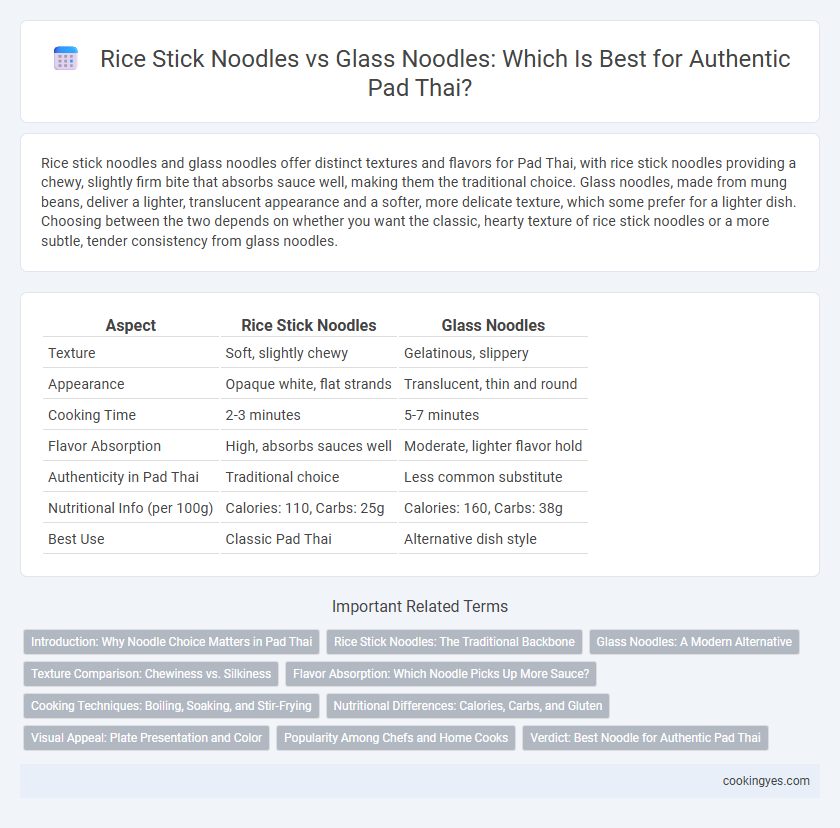Rice stick noodles and glass noodles offer distinct textures and flavors for Pad Thai, with rice stick noodles providing a chewy, slightly firm bite that absorbs sauce well, making them the traditional choice. Glass noodles, made from mung beans, deliver a lighter, translucent appearance and a softer, more delicate texture, which some prefer for a lighter dish. Choosing between the two depends on whether you want the classic, hearty texture of rice stick noodles or a more subtle, tender consistency from glass noodles.
Table of Comparison
| Aspect | Rice Stick Noodles | Glass Noodles |
|---|---|---|
| Texture | Soft, slightly chewy | Gelatinous, slippery |
| Appearance | Opaque white, flat strands | Translucent, thin and round |
| Cooking Time | 2-3 minutes | 5-7 minutes |
| Flavor Absorption | High, absorbs sauces well | Moderate, lighter flavor hold |
| Authenticity in Pad Thai | Traditional choice | Less common substitute |
| Nutritional Info (per 100g) | Calories: 110, Carbs: 25g | Calories: 160, Carbs: 38g |
| Best Use | Classic Pad Thai | Alternative dish style |
Introduction: Why Noodle Choice Matters in Pad Thai
Rice stick noodles, traditionally made from rice flour and water, provide the classic chewy texture essential to authentic Pad Thai. Glass noodles, derived from mung bean starch, offer a translucent appearance and a softer, more gelatinous bite that alters the dish's characteristic mouthfeel. Selecting the appropriate noodle fundamentally affects flavor absorption, texture balance, and the overall sensory experience of Pad Thai.
Rice Stick Noodles: The Traditional Backbone
Rice stick noodles, made from rice flour and water, form the traditional backbone of Pad Thai, offering a chewy texture that absorbs the sauce perfectly. Their wide, flat shape allows even cooking and enhances the dish's characteristic balance of sweet, sour, and savory flavors. Unlike glass noodles, rice stick noodles maintain firmness without becoming overly slippery, preserving the authentic mouthfeel essential to classic Pad Thai.
Glass Noodles: A Modern Alternative
Glass noodles offer a unique texture and translucency that distinguish them from traditional rice stick noodles used in Pad Thai. Made from mung bean starch, glass noodles provide a slightly chewy consistency and absorb flavors well, making them a modern alternative favored in contemporary variations of the dish. Their gluten-free nature and subtle flavor enhance Pad Thai's balance without overpowering the classic combination of tamarind, lime, and peanuts.
Texture Comparison: Chewiness vs. Silkiness
Rice stick noodles provide a chewy and slightly firm texture essential for authentic Pad Thai, enhancing the bite and mouthfeel. Glass noodles offer a silky, smooth texture but lack the characteristic chewiness that defines the dish's signature contrast. The choice between rice sticks and glass noodles significantly impacts the overall sensory experience, with rice sticks preferred for their resilience and glass noodles for their delicate slip.
Flavor Absorption: Which Noodle Picks Up More Sauce?
Rice stick noodles excel in flavor absorption for Pad Thai, soaking up the tangy tamarind and savory fish sauce more effectively due to their porous texture. Glass noodles, made from mung bean starch, have a slicker surface that tends to hold onto sauces less firmly, resulting in a lighter coating of flavor. The chewy consistency of rice stick noodles also helps trap sauce, making every bite rich and well-seasoned.
Cooking Techniques: Boiling, Soaking, and Stir-Frying
Rice stick noodles require a brief soak in warm water followed by a quick boil to achieve the ideal chewy texture for Pad Thai, while glass noodles need soaking in hot water until softened without boiling to prevent brittleness. During stir-frying, rice stick noodles hold their shape and absorb flavors without becoming mushy, whereas glass noodles demand gentler handling to avoid breaking apart. Mastery of these distinct cooking techniques ensures the authentic texture and flavor balance integral to traditional Pad Thai dishes.
Nutritional Differences: Calories, Carbs, and Gluten
Rice stick noodles for Pad Thai typically contain around 192 calories and 43 grams of carbohydrates per cup, offering a gluten-free option with moderate energy content. Glass noodles, made from mung bean starch, generally have slightly fewer calories, approximately 160 per cup, with about 37 grams of carbohydrates and are also naturally gluten-free. Both noodles provide a low-fat, gluten-free base, but rice stick noodles are higher in calories and carbs, making glass noodles a lighter alternative for those monitoring their caloric intake or carbohydrate consumption.
Visual Appeal: Plate Presentation and Color
Rice stick noodles offer a vibrant, slightly opaque white color that enhances Pad Thai's traditional orange and green hues, creating a visually appealing contrast on the plate. Glass noodles provide a translucent, glossy appearance that adds a delicate, elegant touch but can blend more with the sauce's color, resulting in a subtler presentation. Choosing rice stick noodles maximizes color contrast and plate definition, improving overall visual appeal in classic Pad Thai presentation.
Popularity Among Chefs and Home Cooks
Rice stick noodles are favored by most Pad Thai chefs and home cooks due to their ideal texture and ability to absorb the signature tamarind sauce, enhancing the dish's authentic flavor. Glass noodles, while sometimes used as an alternative, lack the chewy consistency that defines traditional Pad Thai and are less popular among culinary professionals. The widespread preference for rice stick noodles highlights their essential role in achieving the classic Pad Thai experience.
Verdict: Best Noodle for Authentic Pad Thai
Rice stick noodles, made from rice flour and water, provide the ideal texture and absorb the tangy-sweet tamarind sauce perfectly, making them the best choice for authentic Pad Thai. Glass noodles, made from mung bean starch, have a slippery texture and do not hold the sauce as well, resulting in a less traditional flavor experience. For genuine Pad Thai flavor and texture, rice stick noodles remain the top recommendation.
Rice stick noodles vs glass noodles for Pad Thai Infographic

 cookingyes.com
cookingyes.com